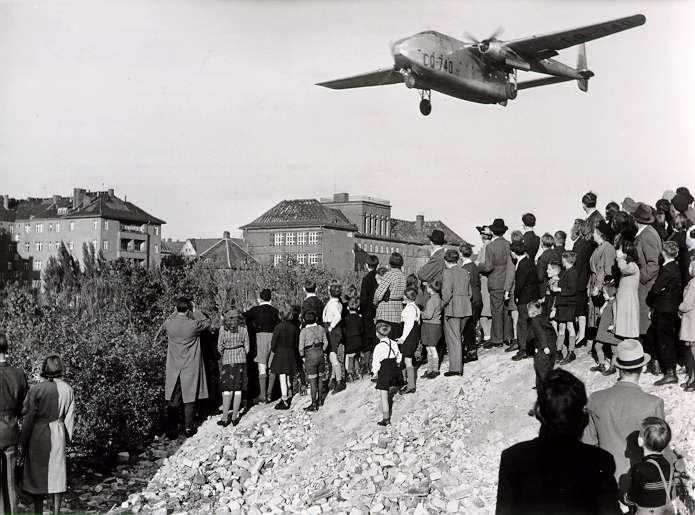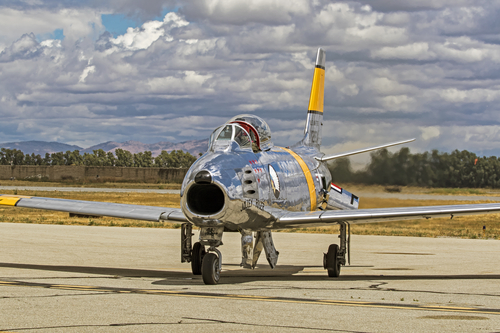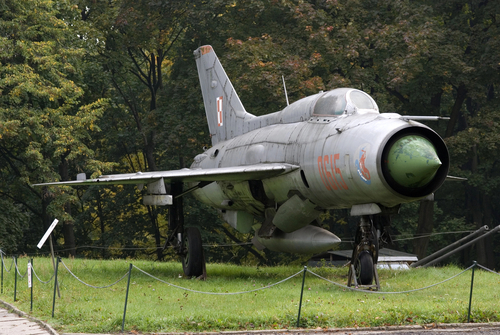
Following the conclusion of World War II, the United States and the Soviet Union embarked on a rivalry for dominance in a worldwide conflict that pitted democracy against communism.

The escalating tensions between these two superpowers resulted in various confrontations, including the Berlin blockade, the shooting down of an American U-2 spy plane, and the Cuban Missile Crisis. Additionally, “hot” conflicts erupted in Korea and Vietnam.

The F-86 Sabre, the first U.S. fighter jet to adopt the swept-wing design inspired by German engineering post-World War II, stands out as one of the notable fighter jets from the Cold War era despite its age. With a top speed of 685 mph in 1948, it held the world record at that time. Over 5,500 of these fighters were manufactured and utilized by more than 20 other countries.

During the Korean War, the F-86 Sabre played a significant role and achieved air superiority throughout the conflict. It faced against the Soviet MiG-15, a formidable adversary in its own right.

Remarkably, by the end of the Korean campaign, the Sabre had downed 792 MiG-15s, while the Soviets had only managed to take down around 100 Sabres. This impressive 8:1 ratio of victories solidifies the Sabre’s reputation as one of the premier fighter jets of the Cold War era.

The Mikoyan-Gurevich MiG-21 fighter aircraft, nicknamed the Fishbed, gained widespread acclaim and was utilized by over 60 nations globally. Originating from the Soviet Union during the Cold War, it stands out as one of the most successful and enduring fighter jets in history.

Renowned for its adaptability in both air-to-air and air-to-ground combat, as well as reconnaissance missions, the aircraft was lauded for its compact size and exceptional agility, making it a formidable contender in aerial dogfights with its superior speed and maneuvering capabilities.

The MiG-21’s ease of production, remarkable maneuverability, and competitive edge posed a significant challenge to many fighter jets of its time. Production commenced in 1959, and to date, it holds the distinction of being the most prolifically produced fighter jet in history, with a total of 10,645 units manufactured.

The Cold War also witnessed the advent of specialized aircraft like the Soviet Sukhoi SU-25. The Soviet Sukhoi SU-25 is primarily utilized as a ground-attack aircraft, although it also features air-to-air armaments.

With a maximum take-off weight of 42,000 pounds, it boasts the capability to transport various missiles and bombs. Its air-to-air capabilities are located on the outer sections of each wing, while the remainder of the aircraft is dedicated to ground attack missions.

Additionally, later versions of the SU-25 were equipped with enhanced navigation systems and a nose-mounted laser rangefinder.

America’s answer to speed and versatility came in the form of the F-4 Phantom II, a multirole fighter that shone in the Vietnam War and Operation Desert Storm.

This jet broke 16 flight records before it even entered production, exhibiting raw power and adaptability.

Meanwhile, the MiG-31 Foxhound held its ground as one of the world’s fastest jets, boasting advanced radar systems capable of engaging multiple targets simultaneously. It played a notable role over Ukraine, showcasing its long-range air-to-air missile capabilities, which remain a crucial component of Russia’s defense strategy.

Regarded as one of the finest fighter aircraft in history, the F-15 Eagle combines exceptional speed with agile maneuverability. Capable of reaching speeds exceeding two and a half times the speed of sound, it can swiftly transition into a dogfight, outmaneuvering almost any adversary with ease.
Relevant articles:
– 6 Best Fighter Jets Developed During The Cold War, SlashGear
– Cold War Fighter Pilot selects Top 10 Fighter Aircraft of 1960, Hush-Kit
– The Best Cold War Fighters (of Every Generation), Jets ’n’ Props
– Cold War Aviation, National Air and Space Museum
